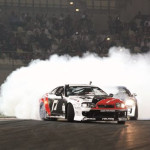Hot on the heels of the Formula E series, as CNN SuperCharged races through some of the world’s most glamorous city centres, Drivemeonline brings you a priority-access feature with exclusive videos, from the reports and shows compiled and anchored by renowned sports presenter Nicki Shields.

Nicki Shields amidst the action in Moscow – image Alistair Guy
The Formula E racing season 2 has already left its footprint (sans the carbon) in Beijing (China), Putrajaya (Malaysia), Punta Del Este (Uruguay), Buenos Aires (Argentina,) and Mexico City (Mexico). Round 6 will be held at Long Beach (USA) on the 2nd of April. Here is a brief and simplified cache of what you should know about Formula E – in relation to Formula 1.
Formula 1 has been around since 1950 while Formula E is just two seasons old. The F1 cars are single-seater petrol driven vehicles while the Formula E is also single-seaters but is driven by – no points for guessing – an electric motor. CNN SuperCharged explains the differences between Formula 1 and Formula E

2015/2016 FIA Formula E Championship. Mexico City ePrix, Saturday 12 March 2016. Jerome D’Ambrosio (FRA) Dragon Racing
Photo: Zak Mauger/LAT/Formula E
The new Formula 1 engines are 1.6 L turbo charged six cylinder powerhouses that spin 15000 times a minute. It can reach speeds of up to 220 miles per hour (350 kmph). The electric motor in a Formula E is powered by a 200 kilogram battery that can propel the car to 140 mph – impressive yet no quite comparable to the petrol head’s formula for thrill.
Watch the CNN Supercharged introductory video
Practice, qualifying and the final race take place across three days in the traditional Formula One races while in the Formula E, it’s all rolled into one long day. While the F1 has its own retreats to celebrate speed, tucked away in suburban areas – like the Silverstone or the Yas Marina – the Formula E takes place in the heart of some of the most happening cities in the world.
Prior to this year, every Formula E car raced in the ePrix was the same but now the teams are free to build their own electric motor. Experienced players like Renault gain much from this arrangement and the race has turned largely competitive even before hitting the tracks.

Mexico City e-Prix, Mexico, Central America. Saturday 12 March 2016 Photo: Andrew Ferraro/LAT/FE
Lucas Di Grassi, driver of ABT Schaeffler Audi Sport, not only ratifies his enthusiasm in turning to Formula E but also sums up the raison d’être of the new electric racing series. “I believe electric mobility will be the mainstream form of human transportation for the public in general and the technology should start to be pushed in racing.” The difference from the Formula 1 races, he feels, is more about the format than about the combustion engine itself; the driver has a higher effect in Formula E, according to Lucas Di Grassi. Watch Lucas talk to Nicki as he gives her driving lessons in the sport’s official safety car – a BMW i8!
While the good news is that several manufacturers have shown the willingness to put their resources into developing Formula E cars, including Jaguar who has stayed away from motorsports for a long time, the curious fact is that the nascent sport is already musing about a driverless (the in-thing these days) race – a war of technologies between robo-drivers. For the time being, it is humans cheering for humans!













